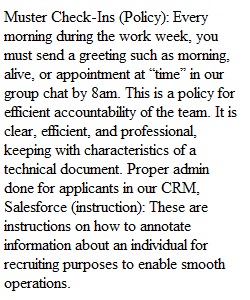


Q Technical information is everywhere. It’s in the cookbooks we use to prepare dinner, and it’s in the advertising information we receive in the mail every day, but we often don’t think of those documents as “technical.” Instead, we more frequently focus on the use of technical information in the workplace. Think about documents like job descriptions, instructions for installing and using software, and so on. But, what else can be considered technical information in the workplace? Before completing this activity, be sure to review your readings and videos for this module and review the Introduction to Technical Writing module notes. You can find the resources and module notes by clicking the links below: • Module 1 Learning Materials • Module Notes: Intro to Technical Communication Let’s Talk The goal of this discussion is to explore your exposure to technical information in the workplace, as well as your thoughts about it. In the Icebreaker activity this week, you analyzed a document to determine whether it met certain characteristics of technical writing and whether it was an effective document overall. In this discussion, we’re shifting the focus to your specific workplace—for either the job you have now or the one you’d like to pursue after graduation. Choose the one that’s easier for you to discuss at this time. Step 1: Craft Your Initial Response When you are ready to make your initial posting, click the "Reply" button. Your initial discussion response should address, at minimum, the following main points: • Identify three distinctly different ways that technical information is used in your workplace. o Identify the documents (e.g., memo, policy, instructions, etc.). o Explain how you know that this information is technical (refer to the characteristics in your reading from this week and in the Icebreaker activity). • Identify one area in your workplace that could benefit from the use of a technical document but where it’s not currently being used—or an alternative or better document where one is already in use. o Maybe this is a new area, or maybe it’s one that everyone assumes doesn’t need further explanation. Maybe it’s an area that has a process document (e.g., an instruction guide or quick reference sheet) that is frequently ignored—or no one realizes it even exists. o Be sure to include your rationale for your choice. Your initial post is due Thursday by 11:59 pm ET. You may post your response using a standard discussion reply, or you can use the built-in video recording tool in Canvas to create an audiovisual response. In total, whether written or spoken, your initial response should not exceed 300 words. Step 2: Connect with Your Classmates and Instructor Respond to the initial posts of at least three classmates and/or your instructor. • When responding to your peers, make connections between your classmates’ experiences and your own. Consider whether you agree or disagree with your classmates’ responses and offer additional information to help develop your classmates’ ideas. • When responding to your instructor, answer any questions that have been posed and offer new, deeper, or broader insight to contribute to the discussion. Peer/instructor interaction posts are due Sunday by 11:59 pm ET. Your peer and/or instructor responses may be posted in written or audiovisual format, and they should not exceed five to seven sentences (or about 100-150 words each). Evaluation The TECH200 Discussion Rubric explains how you will be graded. The discussions combined are worth 20% of your final grade. Outcomes This activity assesses the following module outcomes: • M1-03: Explain various ways that technical information is used in the workplace. (CO1, CO2, CO3, CO7)
View Related Questions